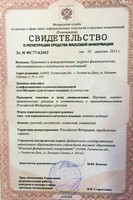Слепота трагична, прикосновение волшебно: новелла Д.Г. Лоуренса «Слепой» как трагикомедия
Аннотация
Ключевые слова: трагическое, комическое, трагикомическое, пафос, «сознание крови», сопротивление, прикосновение, высокое, низкое
Для цитирования: Рогачевская М.С. Слепота трагична, прикосновение волшебно: новелла Д.Г. Лоуренса «Слепой» как трагикомедия // Практики и интерпретации: журнал филологических, образовательных и культурных исследований. 2024. Т. 9. № 1. С. 94–106. DOI: 10.18522/2415-8852-2024-1-94-106
Полный текст:
PDFЛитература
Белинский, В.Г. (1955). Полн. собр. соч.: в 13 т. Т. 7. Москва: АН СССР, Ин-т рус. лит.
Becket, F. (2002). The complete critical guide to D. H. Lawrence. London: Routledge.
Craig, R. (1989). The tragicomic novel. Newark: University of Delaware Press.
Delany, P. (1985). “We shall know each other now”: message and code in D. H. Lawrence’s “The blind man”. Contemporary Literature, 26, 26–39.
Fadiman, R. (1972). The poet as choreographer: Lawrence’s “The blind man”. Journal of Narrative Technique, 2, 60–67.
Gray, M. (1992). A dictionary of literary terms. Beirut: York Press.
Hegel, G.W.F. (1977). Phenomenology of spirit. Oxford: Oxford University Press.
Langdell, Ch. C., & Langdell, T. (2010). Coping with vision loss: understanding the psychological, social, and spiritual effects. Santa Barbara: Praeger.
Lawrence, D.H. (1989). The blind man. In D.H. Lawrence, The great short novels and stories of D.H. Lawrence. London: Robinson Publishing, 243–259.
Lodge, D. (2008) Deaf sentence. New York: Viking.
Mckinney, R. H. (2006). The complexity of the tragicomic vision: ethical implications. Philosophy Today, 50(2), 213–222.
Montgomery, R.L., & Green, R. (2012). Tragicomedy. In R. Greene, S. Cushman, C. Cavanagh, J. Ramazani, P. Rouzer, H. Feinsod, D. Marno, & A. Slessarev (Eds.), The Princeton encyclopedia of poetry and poetics. Princeton: Princeton University Press, 1453–1454.
Padhi, B. D. (1989). H. Lawrence: modes of fictional style. Troy, N.Y.: Whitston Pub Co Inc.
Preston, P. (2003). “I am in a novel”: Lawrence in recent British fiction. In K. Cushman, & E. G. Ingersoll (Eds.), D. H. Lawrence: new worlds. Madison, NJ.: Fairleigh Dickinson University Press, 25–49.
Reistine, F. H. (2022). English tragicomedy: its origin and history. Berkeley: Legare Street Press.
Rosental, G. (2006). German war memories: narratability and the biographical and social functions of remembering. In T. L. Broughton (Ed.), Autobiography (Vol. 3. IX), 208–232.
Schapiro, B. A. (1999). D. H. Lawrence and the paradoxes of psychic life. New York: State University of New York Press.
Squires, M., & Talbot, L. K. (2002). Living at the edge: a biography of D.H. Lawrence and Frieda von Richthofen. Madison: University of Wisconsin Press.
Tate, T. (1998). Modernism, history and the First World War. Manchester and New York: Manchester University Press.
Van Ghent, D. (1963). On sons and lovers. A collection of critical essays (M. Spilka, Ed.). New York: Englewood Cliffs, 15–29.
Wussow, H. (1998). The nightmare of history: the fictions of Virginia Woolf and D.H. Lawrence. Bethlehem: Lehigh University Press.
References
Becket, F. (2002). The complete critical guide to D. H. Lawrence. London: Routledge.
Belinskiy, V.G. (1955). Poln. sobr. soch.: v 13 t. [Complete collection of works in 13 vols.] (Vol. 7). Moscow: AN SSSR, Institute of Russian Literature.
Craig, R. (1989). The tragicomic novel. Newark: University of Delaware Press.
Delany, P. (1985). “We shall know each other now”: message and code in D. H. Lawrence’s “The blind man”. Contemporary Literature, 26, 26–39.
Fadiman, R. (1972). The poet as choreographer: Lawrence’s “The blind man”. Journal of Narrative Technique, 2, 60–67.
Gray, M. (1992). A dictionary of literary terms. Beirut: York Press.
Hegel, G.W.F. (1977). Phenomenology of spirit. Oxford: Oxford University Press.
Langdell, Ch. C., & Langdell, T. (2010). Coping with vision loss: understanding the psychological, social, and spiritual effects. Santa Barbara: Praeger.
Lawrence, D.H. (1989). The blind man. In D.H. Lawrence, The great short novels and stories of D.H. Lawrence. London: Robinson Publishing, 243–259.
Lodge, D. (2008) Deaf sentence. New York: Viking.
Mckinney, R. H. (2006). The complexity of the tragicomic vision: ethical implications. Philosophy Today, 50(2), 213–222.
Montgomery, R.L., & Green, R. (2012). Tragicomedy. In R. Greene, S. Cushman, C. Cavanagh, J. Ramazani, P. Rouzer, H. Feinsod, D. Marno, & A. Slessarev (Eds.), The Princeton encyclopedia of poetry and poetics. Princeton: Princeton University Press, 1453–1454.
Padhi, B. D. (1989). H. Lawrence: modes of fictional style. Troy, N.Y.: Whitston Pub Co Inc.
Preston, P. (2003). “I am in a novel”: Lawrence in recent British fiction. In K. Cushman, & E. G. Ingersoll (Eds.), D. H. Lawrence: new worlds. Madison, NJ.: Fairleigh Dickinson University Press, 25–49.
Reistine, F. H. (2022). English tragicomedy: its origin and history. Berkeley: Legare Street Press.
Rosental, G. (2006). German war memories: narratability and the biographical and social functions of remembering. In T. L. Broughton (Ed.), Autobiography (Vol. 3. IX), 208–232.
Schapiro, B. A. (1999). D. H. Lawrence and the paradoxes of psychic life. New York: State University of New York Press.
Squires, M., & Talbot, L. K. (2002). Living at the edge: a biography of D.H. Lawrence and Frieda von Richthofen. Madison: University of Wisconsin Press.
Tate, T. (1998). Modernism, history and the First World War. Manchester and New York: Manchester University Press.
Van Ghent, D. (1963). On sons and lovers. A collection of critical essays (M. Spilka, Ed.). New York: Englewood Cliffs, 15–29.
Wussow, H. (1998). The nightmare of history: the fictions of Virginia Woolf and D.H. Lawrence. Bethlehem: Lehigh University Press.
Ссылки
- На текущий момент ссылки отсутствуют.
(c) 2024 Марина Станиславовна Рогачевская
ISSN 2415-8852
Свидетельство о регистрации СМИ Эл № ФС77-62683 от 10 августа 2015 г.
Регистрирующий орган: Федеральная служба по надзору в сфере связи, информационных технологий и массовых коммуникаций (Роскомнадзор)
УЧРЕДИТЕЛЬ: ФГАОУ ВО "Южный федеральный университет".
344006, г. Ростов-на-Дону, ул. Большая Садовая, 105/42,
тел. +7 (863) 218-40-00 E-mail: info@sfedu.ru
Адрес редакции: 344006, г. Ростов-на-Дону, пер. Университетский, 93, к. 8, тел. +7(903) 43-12-321
e-mail: pijournal@sfedu.ru

Произведения доступны по лицензии
Creative Commons «Attribution» («Атрибуция») 4.0 Всемирная.

